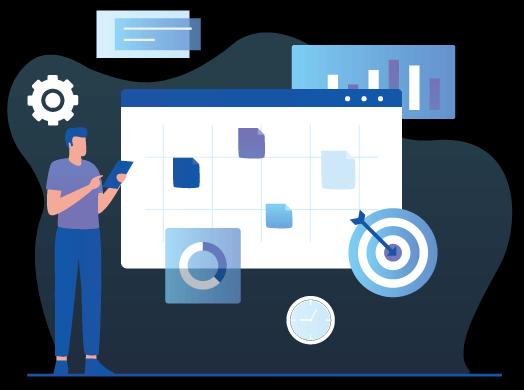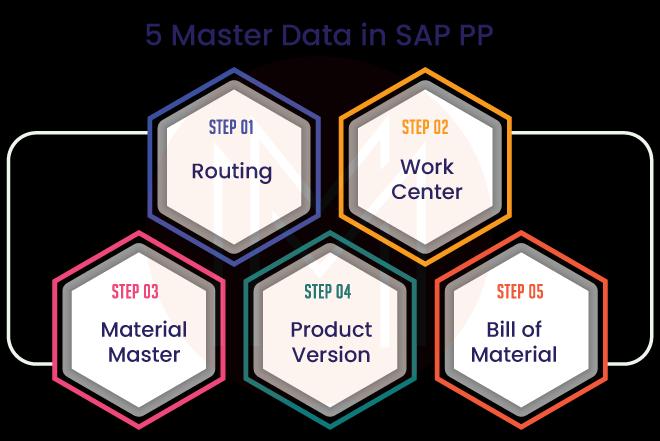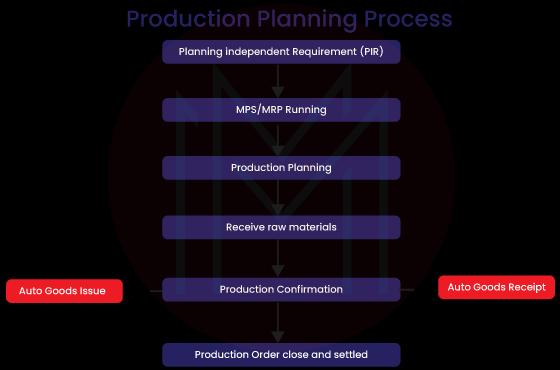Production Planning or PP is a core SAP module. As the name suggests, SAP PP is all about planning the manufacturing process. In more precise words, SAP created the SAP production planning module for supply chain planning, which covers areas such as customer requirement management, production planning in a plant, requirement forecasting, quantity and capacity requirement planning, material requirement planning, and production processing.
All the areas mentioned above are categorized under the PP domain, and it is integrated with other SAP modules. This interconnected network of functions and components is the building block of the SAP ERP system. SAP PP supports three manufacturing methods. These include discrete manufacturing, process manufacturing, and repetitive manufacturing.
Each of these manufacturing methods has its process, which provides unique functionalities to the respective industries. But the core concept in all the ways is based on supply chain management. Supply chain management is about directing the flow of goods and transforming raw materials into finished products. Let us now get into what is SAP PP.

| WHAT IS SAP PP - Table of contents |
What is SAP PP?
SAP Production Planning or SAP PP is the ERP Central Component (ECC) component that helps businesses plan with the manufacturing, sale, and distribution of goods. A part of SAP ECC's logistics function, SAP PP plays a vital role in a manufacturer's supply chain and integrates with other ECC components. This includes materials management, sales and distribution, plant maintenance, quality management, finance, controlling, and human resources. SAP production planning module activities include material requirements planning, bill of material, routings, and capacity planning.
Everything in SAP PP revolves around master data stored and manipulated in centralized master data tables. Master data types include materials master, work center, BOM, and routing. The master data is used to create transactional data in SAP ECC, such as making a production order in production planning, a sales order in sales and distribution, or a purchase order in materials management.
For example, when a production order is created in SAP PP, it uses master data from SAP materials management about the raw materials needed to produce the finished product, which will subsequently be used to create a sales order in SAP SD. On the other hand, SAP PP sub-modules include sales and operations planning along with long-term planning, data management, master production schedule/material requirements planning capacity requirements planning, and shop floor control and information systems.
SAP production planning module or SAP PP module can be configured to meet various industry requirements and includes modules supporting specific manufacturing industry types, including discrete manufacturing, repetitive manufacturing, and process manufacturing. In discrete manufacturing, the number of goods produced changes by lot, and costs are calculated by orders and lots.
In repetitive manufacturing, products remain unchanged over long periods, and production occurs in total quantities, not individual lots. In process manufacturing, products are manufactured in batch-sized lots using a process described in a master recipe that can be adjusted for separate batches. Process manufacturing is mainly used in the chemical, pharmaceutical, and food and beverage industries.
| Want to become a Certified SAP Professional? Visit here to learn about SAP PP Training |
What is Production Planning?
Now that we have a detailed overview of what is SAP PP, let us talk about production planning. Production Planning is a method which aligns demand with manufacturing resources by establishing production and supply plans for finished goods and parts. SAP production planning module is an important module. This is because it tracks and records the expected and actual costs of the manufacturing process. It is fully compatible with SAP's other modules such as SD, MM, QM, and FICO & PM.
Organization Structure in SAP PP
After having a look on what is SAP PP production planning and production planning, it is time for its organizational structure. The system's manufacturing plant locations and storage inside the plants should be accessible in every live production planning module.
Let us look at the importance of production planning of plant and storage locations-
- All master production data is produced at the plant level.
- At the plant level, planning activities are also carried out.
- The production confirmation process and the related movement of goods occur at the plant and storage site stage.
Master Data in SAP PP

Now that we know what is SAP production planning, let us dive deeper for a better understanding of how this works. Generally, master data is immutable for any enterprise and, depending on necessity is rarely altered. In the production preparation module, we need to preserve five master details.
- Material Master - The commodity master includes details on all the goods a corporation procures, manufactures, processes, and distributes. It is a number that uniquely distinguishes a record of the material master and, thus, a material. Materials are grouped with the same essential characteristics and assigned to a category of materials such as finished materials, raw materials, etc. It is used for purposes like purchasing materials, for Goods Flow postings, such as the receipt of goods in inventory management, and for physical inventory postings, verification of invoices for invoices, sales, and distribution process for the fulfillment of sales orders, and for preparing and monitoring content specifications for planning, arranging, and verifying production procedures.
- Bill of Material - The material bill is a complete, formally organized list of the components and the quantity needed for creating or assembling the product. BOMs are used in the planning and costing of material specifications. You can also build up to 99 alternate BOMs for a single commodity. For goods with variants, you can build Super BOM, which has all possible components to manufacture various variants. The suitable part is selected based on the sales order characteristics. For example, all types of frames (with different colors and sizes) can be used in the Product Cycle, and the desired structure is selected by production order based on the color and size chosen in the order of sale.
- Work Center - A Work Center is a system or collection of machines in which manufacturing processes are performed. Job centers are included in the worklist events (Routings). It provides the details for scheduling, capacity, and costing.
- Routing - Routing is nothing but a series of procedures done at the Job Site. It specifies the system time, work time, etc., for the execution of operations.
Check Out: SAP PP Interview Questions
Production Planning Cycle
After going through what is SAP production planning, it is the turn to discuss production planning cycle. This cycle consists of two parts – planning and execution.

- Planning - Generally, development planning is carried out using a budgeted revenue schedule. According to the production cycle periods, Preparation is based on the Sales Schedule to fulfil the sales demands. In the type of expected independent need, demand for the commodity is entered by demand management This demand management data becomes the Commodity Requirement Preparation input. Using the master data such as Bill of Material (BOM) and usable existing plant stocks, MRP tests for the supply of various raw materials required for manufacturing at different times. In supply shortages, procurement specifications are produced for commercially procured products, and expected orders are created for in-house assembled materials. These purchase requisitions and planned orders will initiate the procurement and production cycles. Since MRP works with infinite capabilities, to avoid any capacity bottlenecks, capacity levelling must be don
- Execution - These planned orders are translated to production orders and scheduled per the production timings using master data such as routings. Production orders are issued on the shop floor by the Production Supervisor, and material availability checks can also be performed to check whether any missing components are present. Output is carried out based on routing activities where master data is identified against each routing activity, such as the Work Center. If the product has been completed, the order confirmations are carried out, and products for material use and receipt of goods are put against the order. The order is then given the Delivered (DLV) status, and the material is received at the desired storage place.
Demand Management
Demand Management's role in SAP production planning process flow is to forecast amounts of demand and distribution dates for finished goods and essential assemblies. PIR (planned autonomous requirements) and consumer requirements are used in Market Management. Planning methods for a commodity must be established. It reflects the processes of development for planning and output. There are two ways to do this.
- Make to Stock - The manufacturing of goods without orders for sale, i.e., storage, is carried out independently of orders.
- Make to Order - This technique refers to manufacturing material for a particular order or line object.
Material Requirement Planning (MRP)
Material Requirement Planning identifies any shortages and produces the appropriate procurement components. It calculates net requirements, generates planned orders for in-house manufactured materials, and requires raw materials for purchase. It schedules lead time and calculates planned orders for production dates. It blasts the BOM and produces tender proposals at each stage of the BOM
Capacity Planning and Levelling
Capacity Preparation’s role in SAP production planning process flow is to assess overloads of work center capacity and shift orders to avoid any bottlenecks. MRP creates capacity requirements in the Work Center because MRP operates with unlimited capacity without considering any capacity limitations and schedules all on the work center. It is needed to level the capability at the work center. Each work center's capability can be balanced via a planning table to create a restricted production schedule.
Production Orders
The output of the MRP would be "planned orders," which need to be converted to production orders for further implementation of the process. The Production Order is a signature receipt feature that is not influenced by the MRP run than the Planned Orders.
The Production Order specifies the material and quantity to be produced. It also includes the BOM components and the details of the routing procedure to be performed at the work center. The manufacturing order shall be issued for execution, and the material supply controls shall be carried out to determine if there are any missing parts.
Production Order Confirmation
When products are physically assembled on the factory floor, the order for production must be checked. During confirmation, components can be consumed automatically using a back-flushing system, and products can be collected automatically using a Control Key in the routing service. However, manual issues and receipt of products may be done separately from confirmation instead of the movement of automotive goods.
Any failure to move goods due to a component supply shortage can be reprocessed manually. Activity costs, such as equipment, labor, etc., will also be changed on a factual basis in the manufacturing order during validation. After final confirmation and delivery of the objects, the order shall be granted the status of CNF (Confirmed) and DLV (Delivered). If the warranty is incorrectly posted, we can cancel and post the confirmation with the correct data again.
Production Order Close
The order should be technically completed after the production order has been, or we wish to refrain from proceeding with the demand. It is deleted from the stock/requirement list after the order has been granted TECO status and is no longer considered in planning the material requirement. All dependent reservations will also be deleted from the system.
Conclusion
We need to move on with the rapid technological advancement and acquire the required skillset to keep up with the ongoing market trends and market competition. SAP production planning or SAP PP has made this shift easier. Let us take the example of accounting industry, there, SAP has taken the role of other coding software. SAP production planning process flow has brought the master data of industries in the simplest form. SAP has grown in the international market, thereby increasing the demand for SAP PP professionals in Indian industries as well. Also, due to the switch from offline to online SAP PP continues to grow popular in various arenas of life.Want to become a Certified SAP Professional? Visit here to learn about SAP PP Training
 On-Job Support Service
On-Job Support Service
Online Work Support for your on-job roles.

Our work-support plans provide precise options as per your project tasks. Whether you are a newbie or an experienced professional seeking assistance in completing project tasks, we are here with the following plans to meet your custom needs:
- Pay Per Hour
- Pay Per Week
- Monthly
| Name | Dates | |
|---|---|---|
| SAP PP Training | Jan 06 to Jan 21 | View Details |
| SAP PP Training | Jan 10 to Jan 25 | View Details |
| SAP PP Training | Jan 13 to Jan 28 | View Details |
| SAP PP Training | Jan 17 to Feb 01 | View Details |

Madhuri is a Senior Content Creator at MindMajix. She has written about a range of different topics on various technologies, which include, Splunk, Tensorflow, Selenium, and CEH. She spends most of her time researching on technology, and startups. Connect with her via LinkedIn and Twitter .
















